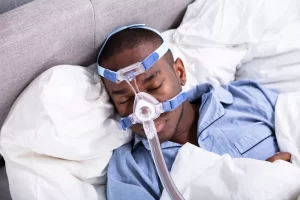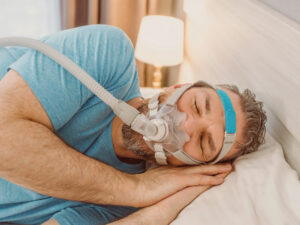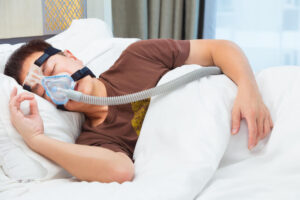Are you struggling with sleep apnea? If so, you may be familiar with the CPAP machine. But do you really know what it is and how it works? In this article we’ll explore the basics of a CPAP machine, from its uses to its potential benefits.
Sleep apnea is an incredibly common disorder that affects many people around the world. It can cause serious health issues, including high blood pressure and heart failure. Thankfully, there are treatments available like CPAP machines that can help relieve sleep apnea symptoms and improve your quality of life.
CPAP stands for Continuous Positive Airway Pressure and it’s a device used to treat sleep apnea by providing a steady flow of air pressure to keep your airways open while you’re sleeping.
Definition Of A CPAP Machine
A CPAP machine is a device used to treat sleep apnea. It helps with airway pressure and keeps the airways open during sleep. The machine delivers pressurized air through a mask that fits over the nose and mouth. The pressurized air helps keep the airways open, which allows for easier breathing while sleeping.
The main benefit of using a CPAP machine is that it can help those who suffer from sleep apnea get a better night’s rest. Patients who use this type of device often report improved energy levels, better concentration, and an overall improvement in their quality of life. Additionally, regular use of a CPAP machine can reduce the risk of high blood pressure, heart attack, stroke, diabetes, and other serious health issues.
CPAP machines are used by many people worldwide to improve their quality of life. With proper care and maintenance, these devices can be relied upon to provide effective treatment for sleep apnea sufferers for many years to come.
What Is A CPAP Machine Used For?
A CPAP machine is a non-invasive device that helps to maintain adequate airflow throughout the night for those who suffer from sleep apnea. It works by providing a constant stream of air pressure to the patient’s airway, which keeps it open and prevents blockages in breathing. This allows the patient to get a restful night’s sleep. The primary purpose of this machine is to reduce or eliminate snoring and improve overall quality of sleep.
The CPAP machine is used in several different ways, depending on the individual needs of each person. It can be used to treat mild, moderate, or severe obstructive sleep apnea (OSA). It may also be prescribed for other types of sleep disorders such as central sleep apnea or mixed apneas. In addition, some people use it for chronic snoring and other symptoms related to OSA.
Since the CPAP machine requires regular maintenance, it’s important for users to follow their doctor’s instructions carefully and make sure they clean their equipment regularly. This will help ensure that the machine continues working properly and help them get a better night’s rest. By using a CPAP machine as prescribed by their doctor, patients can experience improved quality of life through increased energy levels and better overall health.
Benefits Of Using A CPAP Machine
CPAP machines offer many benefits to people who suffer from sleep apnea. The primary benefit of using a CPAP machine is that it can help reduce the severity of sleep apnea symptoms. For those with severe cases, using a CPAP machine can help reduce the number of times they stop breathing during the night. This makes for a better quality of sleep and improved overall health.
Additionally, using a CPAP machine can also help improve daytime energy levels and alertness. This is because it helps ensure that your body gets the oxygen it needs during sleep. With improved oxygen levels, your body will have more energy throughout the day and be able to better focus on tasks at hand.
Lastly, using a CPAP machine can reduce complications associated with sleep apnea such as high blood pressure, heart disease, stroke, headaches, depression and obesity. By reducing these symptoms, you’ll enjoy an improved quality of life overall.
Types Of CPAP Machines
A CPAP machine is a device used to provide positive airway pressure to help treat sleep apnea. There are several different types of CPAP machines available, each designed for specific needs.
The first type of CPAP machine is the standard CPAP, which is the most commonly used and provides a single pressure setting for treating sleep apnea. This type of machine uses a mask that fits over the nose and mouth, supplying pressurized air through a tube connected to the machine. The pressure settings can be adjusted on this type of machine depending on the individual’s needs.
Another type of CPAP machine is an auto-titrating or APAP (Auto Positive Airway Pressure) unit, which automatically adjusts the pressure based on changes in breathing patterns during sleep. This type of machine provides more personalized treatment than a standard CPAP and can be adjusted to provide various pressures as needed throughout the night.
Bi-level or BiPAP (Bi-level Positive Airway Pressure) machines are also available, providing two different levels of pressure: one for inhalation and one for exhalation. This type of machine is often prescribed for patients with more severe cases of sleep apnea who require higher pressures than those provided by a standard CPAP or APAP unit.
No matter what type of CPAP machine you choose, it should be tailored to your individual needs and lifestyle in order to provide effective treatment for your sleep apnea condition. All types can help improve overall health and quality of life by ensuring adequate restful sleep.
Components Of A CPAP Machine
A CPAP machine is composed of several parts. It contains a power supply, an air compressor, and a mask or nasal interface. The power supply enables the machine to operate. The air compressor pumps air through the mask or nasal interface and into the user’s airway at a pre-determined pressure setting. This helps keep the patient’s breathing passages open while they are asleep.
The mask or nasal interface is designed to fit over the nose or mouth of the patient. It is connected to a tube that leads from the air compressor. The tube carries pressurized air from the machine into the patient’s respiratory system, creating an airflow that helps prevent their throat from collapsing during sleep. The size and type of mask will vary depending on individual needs.
The CPAP machine also includes filters and humidifiers, which help reduce airborne contaminants in the room and provide moisture to help relieve dryness in the throat and nasal cavities caused by pressurizing of the airway. The humidifier also helps maintain an optimal level of humidity in the room for better comfort during use of CPAP therapy. In addition, some machines come with additional features such as data tracking, alarms, auto-adjusting pressure settings, and other customizable settings to help personalize treatments for each user’s unique needs.
How Does A CPAP Machine Work?
A CPAP machine is a breathing device that is used to treat sleep apnea. It works by delivering pressurized air through a mask, which helps keep the airways open during sleep. This allows the user to breathe more easily and get a better night’s rest.
The machine consists of three main components: a mask, an air compressor, and a tube connected to the mask. The user wears the mask over their nose and mouth while sleeping. The air compressor pumps air into the tube at a set pressure, which then travels through the tube and into the mask. As the user inhales, this pressurized air enters their lungs, helping to keep their airways open and allowing them to breathe easier.
The CPAP machine also has an adjustable pressure setting that can be adjusted according to the user’s needs. This helps ensure that they receive enough airflow for comfortable sleep without causing any discomfort or irritation. With proper use, CPAP machines can help improve quality of life for those who suffer from sleep apnea.
Setting Up And Using A CPAP Machine
Now that you understand how a CPAP machine works, let’s look at the process of setting it up and using it. Setting up your CPAP machine is straightforward; first, set up your machine and connect the tubing to the CPAP device. Then, attach the mask to the tubing and check for any leaks. Once everything is connected properly, turn on the device and adjust the settings according to your doctor’s instructions.
Using your CPAP machine requires consistency; it’s important to use it every night in order to get the maximum benefit from its usage. It may take some time for you to get used to wearing a mask while sleeping, but with regular use you’ll get used to it quickly. To make sure you’re getting enough air pressure throughout the night, check your device once in a while and make sure all settings are correct.
If you experience any issues or side effects while using your CPAP machine, contact your doctor immediately for further assistance. They can help find solutions that will help make using your machine more comfortable and effective.
Maintaining Your CPAP Equipment
Maintaining your CPAP equipment is an important part of ensuring that it works properly and efficiently. To ensure this, you should check the air filter regularly for dirt or debris buildup. Replace the filter when needed and make sure to keep the machine clean to avoid any build up of bacteria or mold. Additionally, it’s important to replace any broken parts and inspect hoses for cracks or kinks.
It’s also a good idea to inspect your CPAP mask every few days for wear and tear and replace it if necessary. If you notice any leaks, make sure to adjust the straps accordingly and ensure that your mask fits snugly against your face. You should also routinely check the headgear straps for signs of wear and tear as well as examine the humidifier chamber for any cracks or damage.
Finally, always refer to your manufacturer’s instructions before attempting any repair or maintenance on your CPAP machine. It’s important to follow these guidelines in order to ensure that your CPAP machine is working correctly and efficiently at all times.
Troubleshooting Common Issues With A CPAP Machine
Now that you understand the basics of what a CPAP machine is and how to maintain it, let’s discuss troubleshooting common issues associated with the device. Despite regular maintenance, there may still be times when you have difficulty using your CPAP machine properly. If this happens, there are a few things you can try to fix the issue.
First, make sure all of the connections are secure and that none of the components have come loose or disconnected. It is also important to ensure that your CPAP mask is fitted correctly and securely so that no air leaks out as it could affect your sleep apnea treatment. Additionally, check to make sure that all of your settings are correct for pressure, humidity levels and heated tubing temperature if applicable.
If these steps do not resolve the issue, then contact your healthcare provider or manufacturer for assistance in troubleshooting any further problems with your CPAP machine. With their help, you should be able to get back on track with your sleep apnea treatment quickly and easily.
Alternatives To The Use Of A CPAP Machine
A CPAP machine is a device used to treat sleep apnea, a condition where a person stops breathing during their sleep. While it is an effective treatment option, there are alternatives that can be considered if the patient doesn’t want to use a CPAP machine.
One alternative is lifestyle changes such as sleeping on one’s side instead of their back or controlling high blood pressure and cholesterol. Other treatments include oral appliances like mandibular advancement devices (MADs) or tongue-retaining devices (TRDs). These devices help to keep the airways open during sleep by repositioning the jaw or tongue.
Surgery may also be recommended for certain individuals with sleep apnea. Surgical procedures include removing tissue from the soft palate, uvulopalatopharyngoplasty, and maxillomandibular advancement. It’s important to discuss all of these options with your doctor so you can decide which treatment works best for you.
Risks And Side Effects Associated With The Use Of A CPAP Machine
CPAP machines have a number of risks and side effects associated with their use. First, the force generated by the machine can cause discomfort and soreness in the face, nose, or mouth. It can also cause dryness in the airways, which can lead to further issues such as throat irritation and sinus congestion. Second, CPAP machines can be noisy and disruptive for bed partners who are trying to sleep. Third, there is a risk of infection from unclean premises or equipment. It’s important to ensure that the machine is regularly cleaned according to manufacturer instructions in order to prevent this from happening.
There are also some more serious side effects associated with CPAP usage. These include chest pain or difficulty breathing due to excessive pressure being forced into the body at once. In rare cases, it may even lead to pneumothorax (collapsed lung). If any of these symptoms occur while using a CPAP machine it’s important to seek medical attention immediately.
Finally, it’s important for users of CPAP machines to be aware of any potential risks associated with their use. While these machines can provide relief for many people with sleep apnea, it’s important to monitor any signs of distress and seek medical advice if necessary.
Finding The Right Mask For You
Finding the right mask for you is an important part of using a CPAP machine. Your mask needs to fit comfortably and securely to ensure that you’re getting the most out of your therapy. There are several different types of masks available, so it’s important to take the time to find one that works for you.
The first type of mask is a nasal mask. This is designed to fit over your nose, providing a seal around both nostrils. They come in a variety of sizes and styles, so it’s important to try on several different ones before deciding which one is best for you. Nasal masks can be comfortable and easy to use if they are properly fitted.
The second type of mask is an oral or full-face mask. This fits over your nose and mouth, forming a seal around both areas. Many people find these masks more comfortable than nasal masks because they provide extra coverage for the mouth and nose area. Oral/full-face masks tend to be larger than nasal masks, so make sure you measure your face accurately before choosing one that fits well.
When selecting a CPAP mask, comfort is key! Take some time to test out different types of masks until you find one that works best for you and your unique facial features. It may take some trial and error but eventually you’ll find the perfect fit that allows you to get the most out of your CPAP therapy.
Cost Considerations For Purchasing Or Renting A CPAP Machine
Now that you have a better understanding of the different types of masks available, it is important to consider the cost associated with purchasing or renting a CPAP machine. The cost of a CPAP machine varies depending on factors such as the type and features, but on average, CPAP machines can range from $200 to $2,000.
Renting a CPAP machine is often more affordable than buying one outright. Generally, rental periods last months or even years at an agreed-upon rate. It is important to check with your insurance provider before renting or buying a CPAP machine as certain policies may cover all or part of the cost. Additionally, it may be necessary to obtain a prescription from your doctor in order to purchase or rent a CPAP machine.
When deciding whether to buy or rent a CPAP machine, it is essential to take into account your individual needs and preferences. If you require frequent use of a CPAP machine, it may be more cost effective in the long run to purchase one rather than rent one for extended periods of time. On the other hand, if you only need short-term access to a CPAP machine for occasional use, then renting one may be more suitable for your budget. Ultimately, it’s important to shop around and compare prices from different vendors before making an informed decision on which option is best for you.
Insurance Coverage For A CPAP Device
A CPAP machine is a breathing device used to treat sleep apnea. It’s typically covered by insurance, but it can vary depending on the plan. To find out if you’re eligible for coverage, you’ll need to contact your insurance provider and review your plan details.
The type of coverage available also depends on the type of CPAP machine you need. Most plans cover basic machines, such as those with a single pressure setting, but some may not cover more complex models that require multiple settings or additional accessories. Your doctor will be able to recommend the best type of machine for your treatment needs.
If you’re eligible for coverage, your insurance provider will likely require a prescription from your doctor and proof of medical necessity before they’ll approve payment for a CPAP machine. Once approved, you’ll need to pay any applicable deductibles and co-payments when you purchase the device. Knowing what kind of coverage you have ahead of time can help make sure you get the right kind of device for your treatment needs without breaking the bank.
Tips For Getting The Most Out Of Your CPAP Device
Now that you have gained an understanding of insurance coverage for a CPAP device, it’s time to look into how to maximize its use. A CPAP machine is an effective treatment for sleep apnea, but only if it is used correctly and regularly. Here are some tips on getting the most out of your CPAP machine:
First, make sure the mask fits properly. If your mask is too tight or loose, it can cause discomfort and air leaks. Try adjusting the headgear straps until you find a fit that’s comfortable yet secure. Also, if necessary, get help from a specialist to ensure a proper fit on your face.
Second, practice good hygiene with your CPAP device. Cleaning your mask and tubing daily will not only improve the quality of air you breathe but also reduce the risk of infection. It’s also important to clean the water chamber frequently and replace any worn parts as soon as possible.
Finally, establish a regular routine with your CPAP machine and stick with it. This way you can get used to using it every night and make sure you’re getting enough hours of sleep with it each night. Make sure to plan ahead so that if you ever need to travel or stay away from home overnight, you won’t forget your CPAP device at home!
Conclusion
In conclusion, CPAP machines are a great tool for those who suffer from sleep apnea. They provide relief and help people get the restful sleep they need. It’s important to choose the right type of machine, mask, and other components to ensure that you’re getting the most out of your CPAP device. If you’re considering purchasing or renting a CPAP machine, make sure to consider cost and insurance coverage. Finally, follow all instructions for your device and contact your doctor if you have any questions or concerns about using it. With proper use of my CPAP device, I’m confident I will get the restful sleep I need to stay healthy and alert throughout the day.




